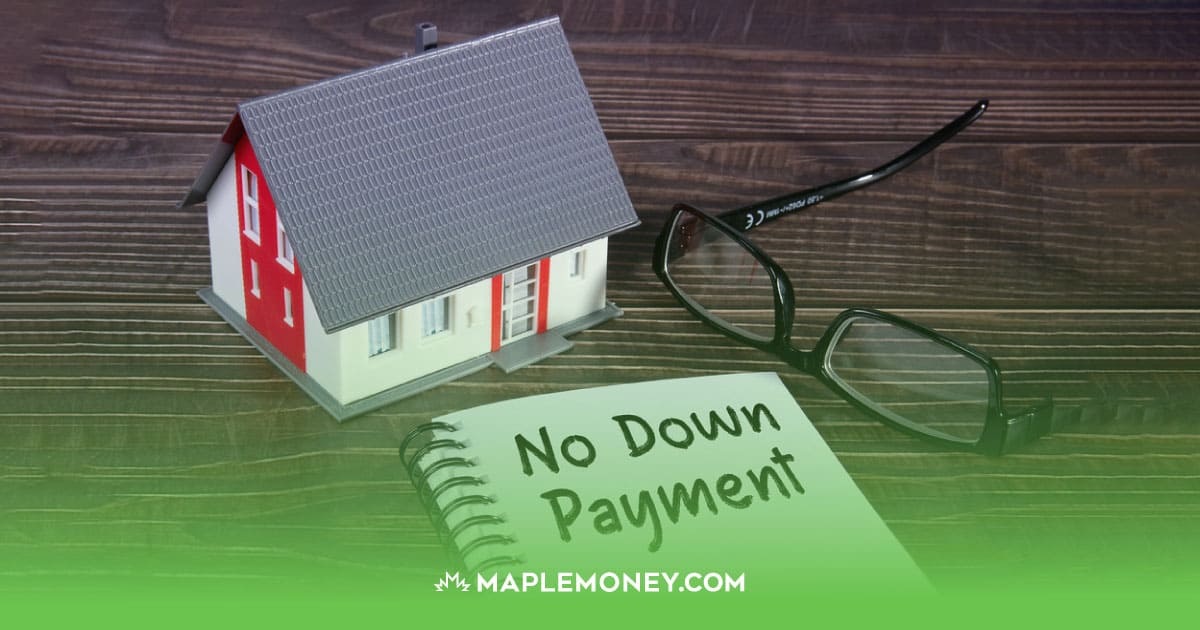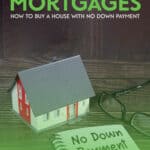Zero Down Mortgages: How to Buy a House with No Down Payment

There was a time when you could go to the bank and qualify for a mortgage without a down payment. But is that still a thing, and if so, is a zero down payment mortgage even a good idea? I’ll answer that question in this article and provide some different ways to come up with your down payment, within the rules.
A History of No Down Payment Mortgages in Canada
During the early 2000s, many Canadian banks were heavily promoting zero-down payment mortgages.
In most cases, it worked like this: the borrower waived the usual mortgage interest rate discount and accepted the higher posted rate in exchange for a 5% upfront discount, which covered the 5% minimum down payment requirement. It was similar to a 5% cash-back mortgage, except the cash-back didn’t end up in the borrower’s pocket; it was used for the down payment.
The borrower remained responsible for covering the closing costs (lawyers fees, etc.) of approximately 1.5% of the home’s purchase price.
However, in 2008, in response to the mortgage crisis, the Canadian government banned no-down payment mortgages from federally-regulated financial institutions and began imposing other mortgage restrictions, such as getting rid of 40-year mortgage amortizations.
Are there Zero-Down Payment Mortgages in Canada Today?
Fast forward to today, and zero-down payment mortgages no longer exist, at least not with mainstream mortgage lenders. However, there are ways to buy a home without saving up the entire down payment in cash.
While saving 100% of your down payment is the ideal scenario, it’s unrealistic for many young Canadians in 2023 who have watched housing prices skyrocket for the past decade, particularly in large cities like Toronto, Vancouver, and Calgary.
But before I explain the alternatives to saving the entire down payment, here’s a closer look at some of the rules surrounding down payments in Canada.
Down Payment Rules in Canada
The minimum down payment required to purchase a home in Canada is 5% of the purchase price on homes up to $500,000. If the purchase price is over $500,000, the portion over $500k would require a down payment of 10%.*
For example, if you purchased a home for $600,000, you’re down payment would be calculated as follows:
The first $500,000 X 5% = $25,000
The additional $100,000 X 10% = $10,000
Your minimum down payment for a $600,000 home would be $35,000.
CMHC-Insured Mortgages
Any time you put less than 20% down on a home purchase, the mortgage must be covered by mortgage insurance, often called mortgage loan insurance or CMHC insurance.
CMHC stands for Canada Mortgage and Housing Corporation, the primary issuer of mortgage default insurance in Canada. Note that there are two other private insurance providers, Sagen (formerly Genworth) and Canada Guaranty.
Mortgage default insurance protects the lender on high-ratio mortgages should the borrower stop making payments on the mortgage.
While CMHC insurance protects the lender, the home buyer is the one who must pay the insurance premium. The higher your down payment, the lower the premium.
To summarize, while you can buy a house with a 5% down payment, you’ll need to come up with 20% down to avoid paying the CMHC premium.
Here are some possible solutions if you need help with the down payment.
Gift from a Family Member
You can accept money for your down payment as a gift from a close family member, usually your parents. To ensure the money isn’t, in fact, a loan, the bank will require a gift letter signed by the family member, attesting that the funds are a gift and that they don’t expect repayment.
Money from the Sale of Another Property
This usually applies if you sell an existing home to buy another one. You can use the proceeds from the sale of your current property for the down payment on your new home. If you have yet to receive the sale proceeds, you can obtain a bridge loan from the bank if you have a firm property sale and have entered an agreement to purchase your new home.
Borrow Money from a Home Equity Line of Credit
If you have a home equity line of credit on an existing property, you can draw down the available credit and use it as a down payment on another property. While you are technically borrowing the funds, they aren’t considered borrowed as they are fully secured by the equity you have in that property.
For example, let’s say you have a HELOC on your principal residence, with $300,000 in available room. You could use up to $300,000 as a down payment on a second property, such as a cottage or rental property.
Remember that the lender will need to include the cost of the borrowed money (and any associated payments on the HELOC) in the debt servicing calculations for the new mortgage.
Take out a Personal Loan or Line of Credit
While I don’t recommend this as a suitable option, you could take out an unsecured loan or line of credit and put the funds toward your down payment. However, there are some things you need to know before taking out a down payment loan.
- A personal loan isn’t an option if you’re taking out a CMHC mortgage with a 5% down payment, as the rules state that the down payment cannot be from borrowed sources. Your options would be saving up the total down payment, a gift letter from parents, or drawing funds from an existing home equity line of credit.
- If you’re taking out a conventional mortgage (20% down payment or higher), your lender may allow you to borrow a portion of the down payment, say over 10%. Note that policies will vary between financial institutions. In this case, you would have to come up with 10% down through non-borrowed means and use loan proceeds for the remainder. Of course, the result will be an additional loan payment and more interest.
- If your mortgage lender allows you to use borrowed funds, note that they will be required to count the extra loan payments when calculating your mortgage affordability. This may reduce the mortgage amount you qualify for.
Other Considerations
- Never use a credit card for your down payment. If you’re considering drawing down your credit card to cover part of your down payment, please don’t. With credit card interest rates above 20%, it could put you in the hole for years, financially speaking. If you can’t do it without a credit card, you’re better off waiting another year and coming up with additional funds another way.
- Make sure you meet your lender’s down payment deadlines! For your lender to approve your mortgage application, you must demonstrate that you have had the down payment proceeds in your possession anywhere from 30 to 90 days before approval (depending on the lender and the mortgage type).
To confirm this, they will ask you for bank statements showing that the money has been accumulating in one of your accounts. So, if you have down payment money sitting in a jar at home or under a mattress, get it in the bank, as your lender cannot track the funds if they’re not in your account.
Note that exceptions can be made – for example, if you are expecting an inheritance or large income tax refund to arrive and plan to use it towards your down payment, the lender may agree to waive the time requirement if the money hasn’t been in your account for the required period.
The No Down Payment Mortgage: Final Thoughts
While the zero-down mortgage no longer exists in Canada, there are ways to come up with a down payment without having to save every penny on your own. But use caution – you can get into trouble if you’re not careful.
I recommend saving as much as you can on your own, and if you use borrowed funds, make sure you are doing so per the policies of your mortgage lender. And avoid using a credit card at all costs.


